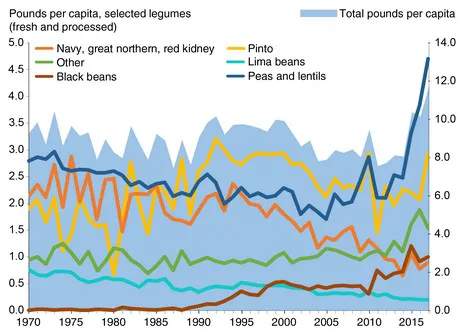Naturally gluten-free, high in fiber, and a good source of protein, Americans’ consumption of legumes (beans, peas, lentils, and chickpeas) has trended upward in recent years, according to ERS’s Loss-Adjusted Food Availability data series (a proxy for consumption).

U.S. consumption of legumes reached 11.7 pounds per person in 2017, up from 8.0 pounds per person in 2014. Rising demand by U.S. consumers for Tex-Mex dishes and food products like hummus drove the increase. From 1970–2017, the largest growth occurred in the consumption of black beans, increasing to 1 pound per capita, and peas and lentils, increasing to 4.7 pounds per capita—the highest consumption among all categories. Pinto beans experienced an uptick in 2017, climbing to 2.9 pounds per person. Despite falling slightly in 2017, consumption of other legumes (chickpeas, black eyed peas, small white, small red, pink, and other beans) has steadily risen, and has grown 63 percent over the past 47 years. However, not all legumes have grown in popularity. Lima bean consumption fell to 0.2 pound per person in 2017—a 74-percent decrease from 1970. Consumption of navy, great northern, and red kidney beans fell 58 percent during this time period as well. The data for this chart come from the Loss-Adjusted Food Availability data series in ERS’s Food Availability (Per Capita) Data System.
